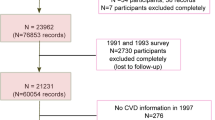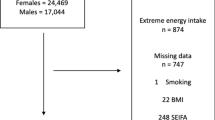Abstract
Objective
To examine whether bean intake (including soybeans) among Japanese adults is associated with risk of disabling dementia severe enough to require care under the national insurance system.
Methods
This cohort study involved 3739 individuals aged 40 to 64 years. The participants were categorized into five groups based on their dietary bean intake estimated by a 24h dietary recall. Hazard ratios and 95% confidence intervals of disabling dementia were estimated using Cox proportional hazard models adjusted for potential confounding factors (smoking, drinking, and intakes of energy and fish).
Results
During the 59,681 person-year follow-up, 670 cases of disabling dementia were observed. A weak inverse association between bean intake and risk of disabling dementia was found; the multivariable hazard ratios (95% CIs) were 0.79 (0.62–1.00), 0.80 (0.63–1.01), 0.84 (0.67–1.06), and 0.78 (0.62–0.99) for the four groups with higher bean intake, respectively, compared with the lowest group (P for trend = 0.21). A significant inverse association was observed for dementia without a history of stroke; for the four groups with higher bean intake the multivariable hazard ratios were 0.81 (0.61–1.08), 0.70 (0.52–0.95), 0.71 (0.52–0.95), and 0.69 (0.51–0.92), respectively, (P for trend = 0.03). No such association was observed for dementia with history of stroke. The group with increased natto intake were inversely associated with risk of disabling dementia (P for trend = 0.003), but tofu intake was not (P for trend = 0.19).
Conclusions
Bean intake was inversely associated with risk of disabling dementia in those without a history of stroke.
This is a preview of subscription content, access via your institution
Access options
Subscribe to this journal
Receive 12 print issues and online access
$259.00 per year
only $21.58 per issue
Buy this article
- Purchase on Springer Link
- Instant access to full article PDF
Prices may be subject to local taxes which are calculated during checkout

Similar content being viewed by others
Data availability
The datasets generated during and/or analyzed during the current study are not publicly available but are available from the corresponding author upon reasonable request and with the permission of the CIRCS committee.
References
World Health Organaization. Dementia. 2021. https://www.who.int/news-room/fact-sheets/detail/dementia.
Cabinet Office GoJ. Situation on ageing: current state and trends on the elderly and their environment. Annual Report on the Ageing Society. 2017. https://www8.cao.go.jp/kourei/whitepaper/w-2017/zenbun/29pdf_index.html.
Prince M, Bryce R, Albanese E, Wimo A, Ribeiro W, Ferri CP. The global prevalence of dementia: a systematic review and metaanalysis. Alzheimer’s Dement: J Alzheimer’s Assoc 2013;9:63–75. e2
Ministry of Health Labour, and Welfare, Japan. National Health and Nutrition Survey. 2019. https://www.mhlw.go.jp/content/10900000/000687163.pdf.
Lu Y, An Y, Lv C, Ma W, Xi Y, Xiao R. Dietary soybean isoflavones in Alzheimer’s disease prevention. Asia Pac J Clin Nutr. 2018;27:946–54.
Soni M, Rahardjo TB, Soekardi R, Sulistyowati Y, Lestariningsih, Yesufu-Udechuku A, et al. Phytoestrogens and cognitive function: a review. Maturitas 2014;77:209–20.
Smith AD, Refsum H, Bottiglieri T, Fenech M, Hooshmand B, McCaddon A, et al. Homocysteine and Dementia: An International Consensus Statement. J Alzheimers Dis. 2018;62:561–70.
Talaei M, Feng L, Yuan JM, Pan A, Koh WP. Dairy, soy, and calcium consumption and risk of cognitive impairment: the Singapore Chinese Health Study. Eur J Nutr. 2020;59:1541–52.
Huang MH, Luetters C, Buckwalter GJ, Seeman TE, Gold EB, Sternfeld B, et al. Dietary genistein intake and cognitive performance in a multiethnic cohort of midlife women. Menopause (N. Y, NY). 2006;13:621–30.
Nakamoto M, Otsuka R, Nishita Y, Tange C, Tomida M, Kato Y, et al. Soy food and isoflavone intake reduces the risk of cognitive impairment in elderly Japanese women. Eur J Clin Nutr. 2018;72:1458–62.
An R, Liu G, Khan N, Yan H, Wang Y. Dietary habits and cognitive impairment risk among oldest-old Chinese. J Gerontol Ser B, Psychol Sci Soc Sci. 2019;74:474–83.
White LR, Petrovitch H, Ross GW, Masaki K, Hardman J, Nelson J, et al. Brain aging and midlife tofu consumption. J Am Coll Nutr. 2000;19:242–55.
Yamagishi K, Muraki I, Kubota Y, Hayama-Terada M, Imano H, Cui R, et al. The Circulatory Risk in Communities Study (CIRCS): A long-term epidemiological study for lifestyle-related disease among Japanese men and women living in communities. J Epidemiol. 2019;29:83–91.
Ikeda A, Yamagishi K, Tanigawa T, Cui R, Yao M, Noda H, et al. Cigarette smoking and risk of disabling dementia in a Japanese rural community: a nested case-control study. Cerebrovasc Dis (Basel, Switz). 2008;25:324–31.
Ministry of Health, Labour and Welfare. Health and Welfare Bureau for the Elderly of Japan Standardized assessment manual for the levels of activity daily living deficiencies among elderly with dementia ([in Japanese]). 1993.
Noda H, Yamagishi K, Ikeda A, Asada T, Iso H. Identification of dementia using standard clinical assessments by primary care physicians in Japan. Geriatrics Gerontol Int. 2018;18:738–44.
Imano H, Iso H, Kiyama M, Yamagishi K, Ohira T, Sato S, et al. Non-fasting blood glucose and risk of incident coronary heart disease in middle-aged general population: the Circulatory Risk in Communities Study (CIRCS). Preve Med. 2012;55:603–7.
Iso H, Terao A, Kitamura A, Sato S, Naito Y, Kiyama M, et al. Calcium intake and blood pressure in seven Japanese populations. Am J Epidemiol. 1991;133:776–83.
Ministry of Education C, Sports, Science and Technology. Standard tables of food compusition in Japan. Japan: Office Gazette Co-operation of Japan; 2015.
Willett WC, Howe GR, Kushi LH. Adjustment for total energy intake in epidemiologic studies. Am J Clin Nutr. 1997;65:1220S–8S.
Imano H, Iso H, Kitamura A, Yamagishi K, Hayama-Terada M, Muraki I, et al. Nonfasting Glucose and Incident Stroke and Its Types - The Circulatory Risk in Communities Study (CIRCS). Circulation J: Off J Jpn Circulation Soc. 2018;82:1598–604.
Yamagishi K, Maruyama K, Ikeda A, Nagao M, Noda H, et al. Dietary fiber intake and risk of incident disabling dementia: the Circulatory Risk in Communities Study. Nutr Neurosci. 2022;6:1–8.
Kritz-Silverstein D, Von Mühlen D, Barrett-Connor E, Bressel MA. Isoflavones and cognitive function in older women: the SOy and Postmenopausal Health In Aging (SOPHIA) Study. Menopause. 2003;10:196–202.
Arai Y, Uehara M, Sato Y, Kimira M, Eboshida A, Adlercreutz H, et al. Comparison of isoflavones among dietary intake, plasma concentration and urinary excretion for accurate estimation of phytoestrogen intake. J Epidemiol. 2000;10:127–35.
Akaza H, Miyanaga N, Takashima N, Naito S, Hirao Y, Tsukamoto T, et al. Comparisons of Percent Equol Producers between Prostate Cancer Patients and Controls: Case-controlled Studies of Isoflavones in Japanese, Korean and American Residents. Jpn J Clin Oncol. 2004;34:86–89.
Toda T, Sakamoto A, Takayanagi T, Yokotsuka K. Changes in Isoflavone Compositions of Soybean Foods during Cooking Process. Food Sci Technol Res. 2000;6:314–9.
Izumi T, Piskula MK, Osawa S, Obata A, Tobe K, Saito M, et al. Soy Isoflavone Aglycones Are Absorbed Faster and in Higher Amounts than Their Glucosides in Humans. J Nutr. 2000;130:1695–9.
Feng JF, He LL, Li D, Yuan LH, Yu HL, Ma WW, et al. Antagonizing effects of soybean isoflavones on β-Amyloid peptide-induced oxidative damage in neuron mitochondria of Rarts. Basic Clin Pharmacol Toxicol. 2012;111:248–53.
LeBlanc E, Janowsky J, Chan B, Nelson H. Hormone replacement therapy and cognitionsystematic review and meta-analysis. Jama 2001;285:1489–99.
Cui C, Birru RL, Snitz BE, Ihara M, Kakuta C, Lopresti BJ, et al. Effects of soy isoflavones on cognitive function: a systematic review and meta-analysis of randomized controlled trials. Nutr Rev. 2020;78:134–44.
Blom HJ, Smulders Y. Overview of homocysteine and folate metabolism. With special references to cardiovascular disease and neural tube defects. J Inherit Metab Dis. 2011;34:75–81.
Agnew-Blais JC, Wassertheil-Smoller S, Kang JH, Hogan PE, Coker LH, Snetselaar LG, et al. Folate, vitamin B-6, and vitamin B-12 intake and mild cognitive impairment and probable dementia in the Women’s Health Initiative Memory Study. J Acad Nutr Dietetics. 2015;115:231–41.
Morris MC, Wang Y, Barnes LL, Bennett DA, Dawson-Hughes B, Booth SL. Nutrients and bioactives in green leafy vegetables and cognitive decline: Prospective study. Neurology. 2018;90:e214–e222.
Corrada MM, Kawas CH, Hallfrisch J, Muller D, Brookmeyer R. Reduced risk of Alzheimer’s disease with high folate intake: the Baltimore Longitudinal Study of Aging. Alzheimer’s Dement: J Alzheimer’s Assoc. 2005;1:11–8.
Luchsinger JA, Tang MX, Miller J, Green R, Mayeux R. Relation of higher folate intake to lower risk of Alzheimer disease in the elderly. Arch Neurol. 2007;64:86–92.
Lefevre-Arbogast S, Feart C, Dartigues JF, Helmer C, Letenneur L, Samieri C. Dietary B Vitamins and a 10-year risk of dementia in older persons. Nutrients. 2016; 8:761.
Durga J, van Boxtel MP, Schouten EG, Kok FJ, Jolles J, Katan MB, et al. Effect of 3-year folic acid supplementation on cognitive function in older adults in the FACIT trial: a randomised, double blind, controlled trial. Lancet. 2007;369:208–16.
Maruyama K, Kubota Y, Sato S, Ishikawa Y, Shimamoto T, Inagawa M, et al. The reproducibility of 24-h dietary recall for estimating mineral intakes and their food sources among middle-aged Japanese men and women. Int J food Sci Nutr. 2009;60:30–40.
Nagahata T, Nakamura M, Ojima T, Kondo I, Ninomiya T, Yoshita K, et al. Relationships among Food Group Intakes, Household Expenditure, and Education Attainment in a General Japanese Population: NIPPON DATA2010. J Epidemiol. 2018;28:S23–S2.
Acknowledgements
The authors thank the healthcare staff of the Ikawa, Minami-Takayasu, and Kyowa communities. The full list of CIRCS investigators is presented in ref. [13]. The authors would also like to thank Thomas Mayers of the Medical English Communications Center, University of Tsukuba, for language revision.
Funding
This study was partly supported by Health and Labour Science Research Grants for Dementia (grant numbers: H21-Ninchisho-Wakate-007 and H24-Ninchisho-Wakate-003) from the Ministry of Health, Labour and Welfare, Japan; JSPS KAKENHI grant numbers 26253043, 17H04121, 18K10097 and 21H03194; Japan FULLHAPP; and the Osaka University International Joint Research Promotion Programme with University College London.
Author information
Authors and Affiliations
Contributions
Conception and design of the study: RK, KY, and H Iso. Analysis of data: RK. Drafting the article: RK, KY, and H Iso; Critical revision of paper: KM, CO, MT, AI, MH, YS, IM, MU, H Imano, EJB, TS, TO, AK, and MK. All authors contributed to the article and have approved the submission of the article for publication.
Corresponding author
Ethics declarations
Competing interests
The authors declare no competing interests.
Additional information
Publisher’s note Springer Nature remains neutral with regard to jurisdictional claims in published maps and institutional affiliations.
Supplementary information
Rights and permissions
Springer Nature or its licensor holds exclusive rights to this article under a publishing agreement with the author(s) or other rightsholder(s); author self-archiving of the accepted manuscript version of this article is solely governed by the terms of such publishing agreement and applicable law.
About this article
Cite this article
Kishida, R., Yamagishi, K., Maruyama, K. et al. Dietary intake of beans and risk of disabling dementia: The Circulatory Risk in Communities Study (CIRCS). Eur J Clin Nutr 77, 65–70 (2023). https://doi.org/10.1038/s41430-022-01188-1
Received:
Revised:
Accepted:
Published:
Issue Date:
DOI: https://doi.org/10.1038/s41430-022-01188-1



